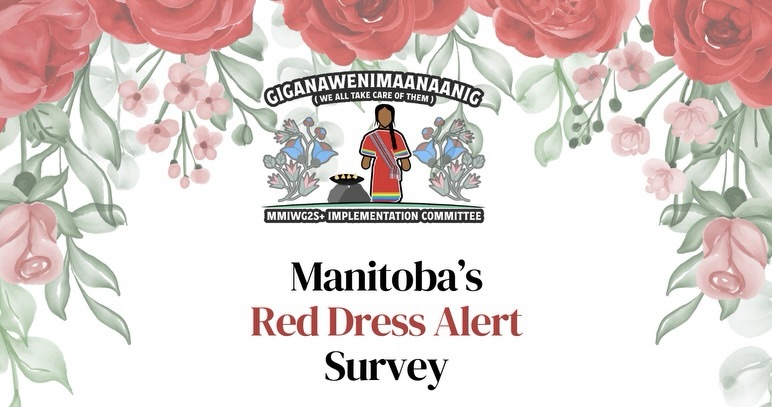By Regan Treewater, Local Journalism Initiative Reporter
(ANNews) – “The broader community, coast-to-coast, already knows that the targeting of MMIWG2S+ epidemic is a nationwide crisis, but people need to know that they also have the ability to contribute to saving lives,” commented Alaya McIvor, the Community Culture Animator for the Red Dress Alert initiative being pioneered in Manitoba. May 5th marked a day to promote MMIWG2S+ awareness across Canada, and in a recent online interview with the Alberta Native News, McIvor and her colleague Denise Cook, the Project Lead for the Red Dress Alert, expanded on how their team’s efforts are informed by direct community engagement.
 “Manitoba is ground-zero for the crisis,” McIvor elaborated. “We are learning from our communities: the families of victims, service providers, and others impacted by the targeting for vulnerable people.” In a press release distributed by Crown-Indigenous Relations and Northern Affairs Canada, Sandra DeLaronde of Giganawenimaanaanig noted: “The Red Dress Alert Pilot Project, to be designed and led by community and families, represents a vital opportunity to save lives and create a safer province. By responding swiftly and incorporating lived experiences, this is an opportunity to protect those most vulnerable and targeted in our society.” Both McIvor and Cook explained that more detailed findings are forthcoming and will be officially published in June of this year, but that their efforts are currently centered on gathering as much information and community input as possible.
“Manitoba is ground-zero for the crisis,” McIvor elaborated. “We are learning from our communities: the families of victims, service providers, and others impacted by the targeting for vulnerable people.” In a press release distributed by Crown-Indigenous Relations and Northern Affairs Canada, Sandra DeLaronde of Giganawenimaanaanig noted: “The Red Dress Alert Pilot Project, to be designed and led by community and families, represents a vital opportunity to save lives and create a safer province. By responding swiftly and incorporating lived experiences, this is an opportunity to protect those most vulnerable and targeted in our society.” Both McIvor and Cook explained that more detailed findings are forthcoming and will be officially published in June of this year, but that their efforts are currently centered on gathering as much information and community input as possible.
Thus far there have been 21 community engagement sessions in Northern and Southern Manitoba, as well as its main urban centers. “We need for the families impacted by the crisis, who might still be searching for loved ones, to feel heard and supported.” Cook also noted that for some, the rawness of their trauma limits their current ability to provide their insights but that the Red Dress Alert is ever evolving and always welcoming of input.
To this end, the initiative’s team is encouraging the wider Canadian community to fill out a survey to assess how their implementation of the Red Dress Alert system can best address the needs of those most vulnerable. Feedback from communities outside of Manitoba is also critical for approaching the design and implementation of The Red Dress Alert, which organizers hope to launch in Fall 2025. The potential for other provinces and territories to use similar systems could be the most direct community action to make an immediate impact.
“The violence against Indigenous women, girls, Two-Spirit and gender-diverse people has to come to an end. Indigenous voices, grassroots service providers and organizers on the front lines of the crisis have called for action. Canada, Manitoba, and Giganawenimaanaanig are working quickly and closely together to advance the Red Dress Alert and bring us one step closer to ensuring that when an Indigenous woman, girl, Two-Spirit, or gender-diverse person goes missing, action is taken so they can be brought home safely,” commented Gary Anandasangaree, Minister of Crown-Indigenous Relations.
McIvor reiterated that the Red Dress Alert initiative and development builds upon work that has been many years in the making, but the crisis is immediate and with every passing day, communities are losing loved ones because there is no uniform and universal communication network for reporting disappearances.
Cook added: “Our next step is to begin connecting with law enforcement. We first wanted to listen to the voices and lived experiences of those living this reality: those with feet on the ground working daily to prevent these tragedies and support families. We needed to know the scope of how the crisis looks in each unique community, that way we could organize this information and know more clearly what it is we are looking for from law enforcement. Family members across the province know what they want.”
McIvor and Cook would like Alberta Native News readers to feel encouraged to share their voices and experiences through their survey. “All of those missing are real human beings; they are sacred and loved people,” Cook stated with conviction.
“One thing I’ve always said throughout the engagement sessions is that everyone who has the opportunity to keep our community safe should participate actively in doing that. It is not just on the shoulders of our team or the service providers; we need the wider community to join us.”
McIvor, who herself has been impacted by this epidemic wants people to know: “We need people to have these conversations about awareness and reporting. This should be a topic of conversation around kitchen tables, and everyone should know what to do if they need to report.”
The team at Red Dress Alert would also like to remind the public that the Missing and Murdered Indigenous Women and Girls Crisis Line is a nationwide toll-free number with support staff answering calls 24/7 from those in need of mental health, trauma, and other resources: 1-844-413-6649
The Red Dress Alert survey can be accessed online: https://www.surveymonkey.com/r/Y3F92XZ



Be the first to comment on "Red Dress Alert System will help save lives"